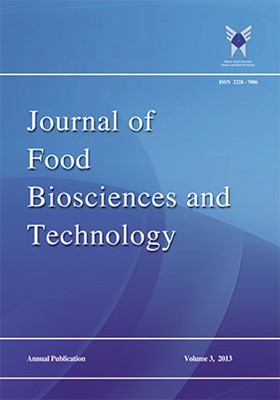Functional, Sensory and Microbial Properties of Milk Fortified by Bioactive Peptides Derived from Fish Waste Collagen
Subject Areas : food microbiologyA. Samimiazad 1 , M.R. Ehsani 2 , Sh. Shabani 3
1 - MSc Graduated of the Department of Food Science and Technology, Science and Research Branch, Islamic Azad University, Tehran, Iran.
2 - Professor of the Department of Food Science and Technology, Science and Research Branch, Islamic Azad University, Tehran, Iran.
3 - Academic Member of the Department of Food Science and Technology, Science and Research Branch, Islamic Azad University, Tehran, Iran.
Keywords:
Abstract :
Anon. (1993). Iran national standard for milk-Determination of specific gravity (lacto-densitometer)-Test method no. 638. Accessed http://standard.isiri.gov.ir/StandardFiles/638.htm. [In Persian].
Anon. (2001). Iran national standard for cheese-Determination of titrable acidity-Test method no. 2852. Accessed http://standard.isiri.gov.ir/StandardFiles/2852.htm. [In Persian].
Anon. (2017). Iran national standard for Raw Milk-Specification and Test Methods-Test method no. 164. Accessed http://standard.isiri.gov.ir/StandardFiles/164.htm. [In Persian].
Anon. (2018). Iran national standard for Milk-Determination of total nitrogen-Test method no. 639. Accessed http://standard.isiri.gov.ir/StandardFiles/639.htm [In Persian].
Anon. (2015). Iran national standard for Microbiology of the food chain-Horizontal method for the enumeration of microorganisms-Part 1: Colony count at 30 °C by the pour plate technique-Test method no. 5272-1. Accessed http://standard.isiri.gov.ir/StandardFiles/5272-1.htm [In Persian].
Anon. (2007). Iran national standard for Microbiology of food and animal feeding stuffs-Horizontal method for the enumeration of coliforms-Colony-count technique-Test method no. 9263. Accessed http://standard.isiri.gov.ir/StandardFiles/9263.pdf [In Persian].
Anon. (2011). The production of collagen hydrolysate, Rousselot Company, France.
Bello, A. E. & Oesser, S. (2006). Collagen hydrolysate for the treatment of osteoarthritis and other joint disorders: a review of the literature. Current medical research and opinion, 22(11), 2221-2232.
Bilek, S. E. & Bayram, S. K. (2015). Fruit juice drink production containing hydrolyzed collagen. Journal of functional foods, 14, 562-569.
Chen, Y. P., Liang, C. H., Wu, H. T., Pang, H. Y., Chen, C., Wang, G. H. & Chan, L. P. (2018). Antioxidant and anti-inflammatory capacities of collagen peptides from milkfish (Chanos chanos) scales. Journal of food science and technology, 55(6), 2310-2317.
Clark, S., Costello, M., Drake, M. & Bodyfelt, F. (Eds.). (2009). The sensory evaluation of dairy products. Springer Science & Business Media.
Dhaka, J. R. (1982). Buffer capacity & viscosity of buffalo milk as influenced by various additives (Doctoral dissertation, ICAR-NDRI, Karnal).
Dar, Q. A., Schott, E. M., Catheline, S. E., Maynard, R. D., Liu, Z., Kamal, F. & Zuscik, M. J. (2017). Daily oral consumption of hydrolyzed type 1 collagen is chondroprotective and anti-inflammatory in murine posttraumatic osteoarthritis. PloS one, 12(4), e0174705.
Felician, F. F., Xia, C., Qi, W. & Xu, H. (2018). Collagen from marine biological sources and medical applications. Chemistry & biodiversity, 15(5), e1700557.
Gálvez, A., López, R. L., Pulido, R. P. & Burgos, M. J. G. (2014). Natural antimicrobials for food biopreservation. In Food biopreservation (pp. 3-14). Springer, New York, NY.
El-Din, A. G., Hassan, A. S. H., El-Behairy, S. A. & Mohamed, E. A. (2012). Impact of zinc and iron salts fortification of buffalo's milk on the dairy product. World Journal of Dairy & Food Sciences, 7(1), 21-27.
Harnedy, P. A. & FitzGerald, R. J. (2012). Bioactive peptides from marine processing waste and shellfish: A review. Journal of functional foods, 4(1), 6-24.
Hays, N. P., Kim, H., Wells, A. M., Kajkenova, O. & Evans, W. J. (2009). Effects of whey and fortified collagen hydrolysate protein supplements on nitrogen balance and body composition in older women. Journal of the American dietetic association, 109(6), 1082-1087.
Holt, C. & Horne, D. S. (1996). its implications for dairy technology. Netherlands Milk & Dairy Journal, 50, 85-1.
Jia, J., Zhou, Y., Lu, J., Chen, A., Li, Y. & Zheng, G. (2010). Enzymatic hydrolysis of Alaska pollack (Theragra chalcogramma) skin and antioxidant activity of the resulting hydrolysate. Journal of the Science of Food and Agriculture, 90(4), 635-640.
Lewis, M. J. (1990). Physical properties of foods and food processing systems. Elsevier.
Pralhadrao, J. V., Arora, S., Shilpashree, B. G., Sharma, V., Singh, A. K. & Panjagari, N. R. (2021). Standardization of model for the production of spray dried whey protein-zinc complex and its acceptability in milk. LWT, 137, 110450.
Rana, B., Kaushik, R., Kaushal, K., Arora, S., Kaushal, A., Gupta, S. & Kaushik, P. (2018). Physicochemical and electrochemical properties of zinc fortified milk. Food bioscience, 21, 117-124.
Sadhu, S. P. (2018). Effect of cold chain interruptions on the shelf-life of fluid pasteurised skim milk at the consumer stage. Brazilian Journal of Food Technology, 21.
Sharma, A., Shree, B. S., Arora, S. & Tomar, S. K. (2015). Lactose–Zinc complex preparation and evaluation of acceptability of complex in milk. LWT-Food Science and Technology, 64(1), 275-281.
Song, D. F., Zhu, M. Y. & Gu, Q. (2014). Purification and characterization of plantaricin ZJ5, a new bacteriocin produced by Lactobacillus plantarum ZJ5. PLoS One, 9(8), e105549.
Tang, L., Chen, S., Su, W., Weng, W., Osako, K. & Tanaka, M. (2015). Physicochemical properties and film-forming ability of fish skin collagen extracted from different freshwater species. Process Biochemistry, 50(1), 148-155.
Walstra, P. (1999). Dairy technology: principles of milk properties and processes. CRC Press.
Walther, B. & Sieber, R. (2011). Bioactive proteins and peptides in foods. International Journal for Vitamin and Nutrition Research, 81(2), 181.
Wang, C., Li, B. & Ao, J. (2012). Separation and identification of zinc-chelating peptides from sesame protein hydrolysate using IMAC-Zn2+ and LC–MS/MS. Food chemistry, 134(2), 1231-1238.
Wang, S., Zeng, X., Yang, Q. & Qiao, S. (2016). Antimicrobial peptides as potential alternatives to antibiotics in food animal industry. International journal of molecular sciences, 17(5), 603.
Yang, S., Li, J., Aweya, J. J., Yuan, Z., Weng, W., Zhang, Y. & Liu, G. M. (2020). Antimicrobial mechanism of Larimichthys crocea whey acidic protein-derived peptide (LCWAP) against Staphylococcus aureus and its application in milk. International Journal of Food Microbiology, 335, 108891.


